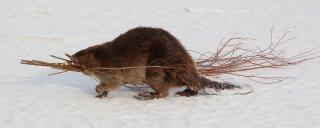 |
| Fact Sheet |
| Scientific Name |
Castor canadensis |
| Description |
Beavers are large, semiaquatic rodents, with short, dense fur that ranges from light brown to nearly black. Beavers have short ears, short legs, large webbed rear feet and a wide, flat, hairless tail that assists in swimming. |
Tracks |
Front– 2" L, 2" W Rear– 6" L, 4" W |
| Total Length |
39-47 inches |
| Weight |
24-57 pounds |
| Habitat |
Beavers are found in lakes, ponds, streams and rivers throughout the state. They often build dams to back up water and live in lodges built of logs and mud packed together. Beaver lodges usually have 1-2 underwater openings with a platform inside that sits several inches above the water. |
| Breeding Season |
January-March |
| Gestation Period |
107 days |
| Litter Size |
1-8 (average 3-4) |
| Social Aspects |
Beavers live in family groups comprised of a mated pair and off spring of differing ages. Young beavers typically disperse from their natal home ranges at age 2. |
| Status |
Beavers are common in North Dakota waterways and have a yearround open harvest season. |
| Food Habits |
Beavers are herbivorous and eat bark, buds and twigs from trees and shrubs, as well as other aquatic vegetation such as roots of reeds and cattails. Aspen and willow are preferred tree species. |
| Fun Facts |
Explorers first traveled to North Dakota in search of beavers to make felt hats. High demand and unregulated harvest led to their near disappearance from the state by the early 1900s. In 1934, the Game and Fish Department began translocating beavers around the state to reestablish populations. These efforts were a success and in 1951 a season on beavers was reopened. |


